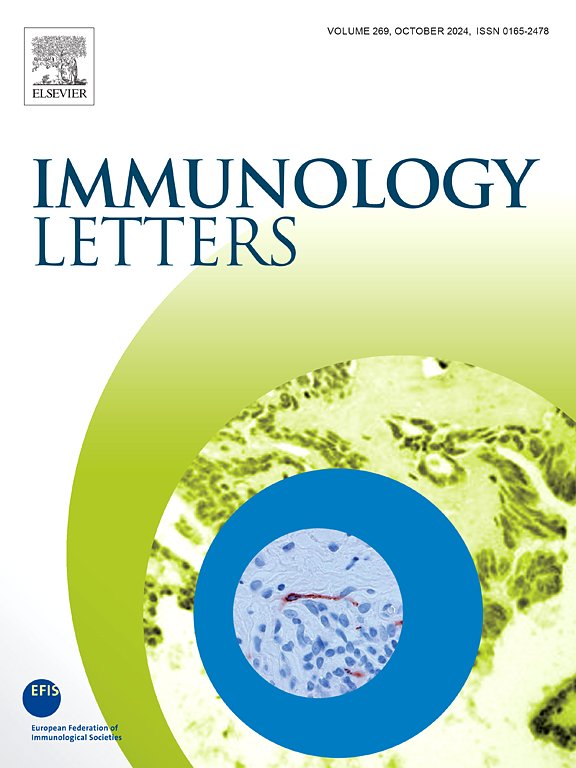Double positive IL-17A+IFN-γ+CCR6+ ILCs contribute towards the immunopathology of lepromatous leprosy
IF 2.8
4区 医学
Q3 IMMUNOLOGY
引用次数: 0
Abstract
Leprosy is a skin disease caused by Mycobacterium leprae, characterized by both localized and generalized immune responses. Th1/17 lymphocytes play a crucial role in the immune response against M. leprae. However, adaptive immunity alone is not sufficient to completely eradicate the pathogen, suggesting the involvement of other innate immune cells in pathogen removal. Therefore, we investigated innate lymphoid cells (ILCs), which are the innate counterparts of helper T cells in adaptive immunity and are known to produce IFN-γ and IL-17. In the present study, we evaluated the expression of ILC1 and ILC3 in borderline tuberculoid (BT) and lepromatous leprosy (LL) lesional skin by flow cytometry and real time PCR. Further, the expression of various in-situ genes, including cytokines, chemokines, cytokine receptors chemokine receptors, and transcription factors by qPCR in skin lesions of leprosy patients were analyzed. The phenotypes of ILC1 and ILC3 cells were determined as CD3negCCR6+CD19negIFN-γ+ and CD3negCCR6+CD19negIL-17A+, respectively, by flow-cytometry analysis. BT skin lesions represents high CCR6+expression on total ILCs as compared to LL patients. Our results clearly indicate that ILC1 and ILC3 were highly expressed in skin lesions of BT as compared to LL leprosy patients. Moreover, we observed that double positive (DP) CD3negCCR6+CD19negIFN-γ+IL-17A+ ILCs were up-regulated in LL and showed a pathogenic role. The gene expression of IL-17A and IFN-γ were found to be significantly positively correlated with the percentage of CCR6+ ILCs. On the other hand, CCR6neg ILCs were negatively correlated with ILC1 and ILC3 associated markers. Summarily our results clearly suggest that both ILC1 and ILC3 are important and immune-protective, on the contrary DP (IFN-γ+IL-17A+) ILCs may promote progression and immunopathology of leprosy.
双阳性IL-17A+IFN-γ+CCR6+ ilc参与麻风性麻风的免疫病理。
麻风病是由麻风分枝杆菌引起的一种皮肤病,其特点是局部和全身免疫反应。Th1/17淋巴细胞在麻风分枝杆菌的免疫应答中起关键作用。然而,适应性免疫本身不足以完全根除病原体,这表明其他先天免疫细胞也参与了病原体的清除。因此,我们研究了先天淋巴样细胞(ILCs),它是适应性免疫中辅助性T细胞的先天对应物,已知可以产生IFN-γ和IL-17。在本研究中,我们采用流式细胞术和实时PCR检测了ILC1和ILC3在交界性结核菌(BT)和麻风性麻风(LL)病变皮肤中的表达。通过qPCR分析麻风患者皮损中细胞因子、趋化因子、细胞因子受体、趋化因子受体、转录因子等多种原位基因的表达情况。流式细胞术检测ILC1和ILC3细胞的表型分别为CD3negCCR6+CD19negIFN-γ+和CD3negCCR6+CD19negIL-17A+。与LL患者相比,BT皮肤病变的总ILCs中CCR6+表达较高。我们的研究结果清楚地表明,ILC1和ILC3在BT患者的皮肤病变中比LL麻风患者高表达。此外,我们观察到双阳性(DP) CD3negCCR6+CD19negIFN-γ+IL-17A+ ILCs在LL中上调,并显示出致病作用。IL-17A和IFN-γ的基因表达与CCR6+ ILCs的比例呈显著正相关。另一方面,CCR6neg ILCs与ILC1和ILC3相关标记物呈负相关。总之,我们的研究结果清楚地表明,ILC1和ILC3都是重要的和免疫保护的,相反,DP (IFN-γ+IL-17A+) ILCs可能促进麻风病的进展和免疫病理。
本文章由计算机程序翻译,如有差异,请以英文原文为准。
求助全文
约1分钟内获得全文
求助全文
来源期刊

Immunology letters
医学-免疫学
CiteScore
7.60
自引率
0.00%
发文量
86
审稿时长
44 days
期刊介绍:
Immunology Letters provides a vehicle for the speedy publication of experimental papers, (mini)Reviews and Letters to the Editor addressing all aspects of molecular and cellular immunology. The essential criteria for publication will be clarity, experimental soundness and novelty. Results contradictory to current accepted thinking or ideas divergent from actual dogmas will be considered for publication provided that they are based on solid experimental findings.
Preference will be given to papers of immediate importance to other investigators, either by their experimental data, new ideas or new methodology. Scientific correspondence to the Editor-in-Chief related to the published papers may also be accepted provided that they are short and scientifically relevant to the papers mentioned, in order to provide a continuing forum for discussion.
 求助内容:
求助内容: 应助结果提醒方式:
应助结果提醒方式:


